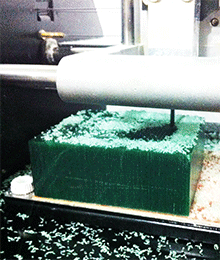Molding and Casting
Week 9
Assignment: design a 3D mold, machine it, and cast parts from it
Programs/Machines:Rhinoceros, Roland Modela MDX-20, Fab Modules
Lessons Learned: Be patient with the 3d subtractive milling capabilities of the Roland, small jobs may take longer than expected.
Barcelona has an amazing interstitial complexity. There have been countless times while meandering through the streets I have stumbled upon a truly unique and genuine event, installation, or entity. One such interesting find are the many street altars scattered about the old-town sections of the city. I have never been religious so these points of sacred significance strike me more as sculpture; sometimes seamlessly blending into the ever present street art that occupies the walls throughout the winding passageways. In spirit of these religious moments I sought to create a Patron Saint of Digital Fabrication, melding street art and street altar mentalities for my molding and casting project.
"Patron Saint of Something"
Working from a Thingiverse file with 134334 faces I started to create my digital saint.
Through use of Rhino's integrated computing I used the command "reducemesh" to achieve a more faceted form. By trial and error I reduced the face count from a whopping 134334 faces 99.90% to a visually pleasing 134. This was then fit into the wax extents for milling with the Roland Modela.
Once my digital file suited all requirements for milling I exported it as an ".stl" file, in order to open it in the Fab Modules for the Modela. It is imperative to make sure to secure the machinable wax well on the bed of the Modela as forces can move and shift the wax. For the milling I used the 1/8 inch tooling bit and did not choose to use a finishing bit as the rough nature of the machining worked well with the faceted bust. In total my mold took 25 minutes to be produced.
I wanted to achieve a timeless artifact so I chose to cast metal; in order to hold such a high temperature material I needed to use Mold Max 60 heat resistant silicone for the mold. The first steps are spraying the cavity with mold release, mixing the silicone 100 parts A to 3 parts B by weight, pouring the mixture, vibrating the cast material to remove air, and waiting 24 hours for curing to complete.
Once my pattern had cured I realized the time it took to use the metal casting, so I chose to quickly produce weather resistant urethane plastic. The mixing ratio and curing time was much more efficient so I breezed through the process. The plastic had a 1:1 mixing ratio by volume, the substance could be poured into any cavity, and the curing process lasted for 30 minutes and afterwards you were able to repeat the process.

After I had produced a large amount of figurines I explored the city of Barcelona finding suitable locations to establish digital pilgrimage sites. While creating metal saints didn't work out, I was able to also create clay casts in addition to urethane plastic objects. The process of creating clay figurines was even more simple as the clay was a type of rapid air dry variety that hardened to the rigidity of baked clay but in open air. I am excited to find out that with the Modela it is possible to mill 3-dimensionally, but they aren't the most efficient machines when there is a whole class needing to use them.
∼
Downloads







